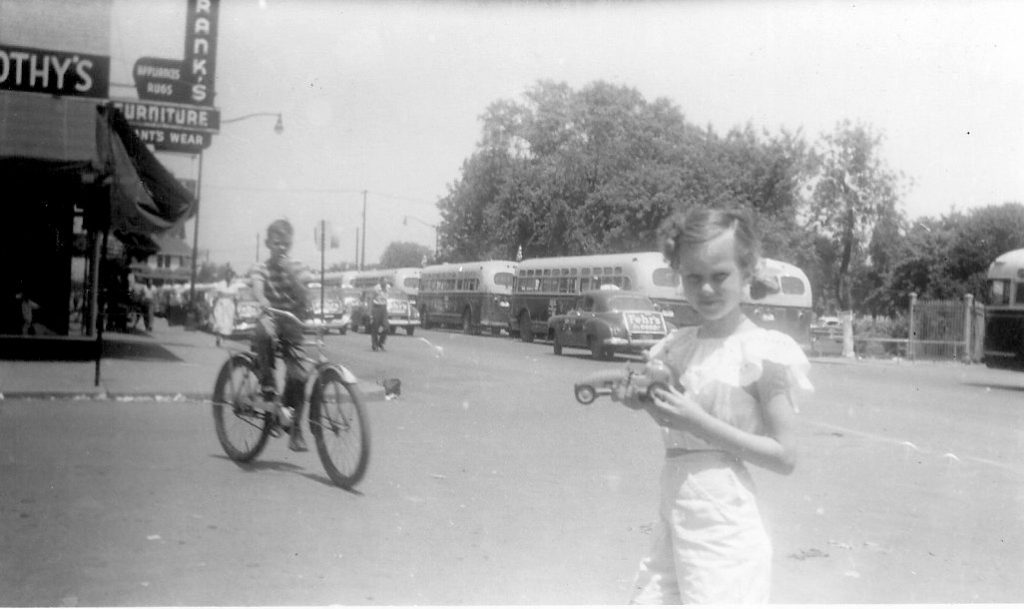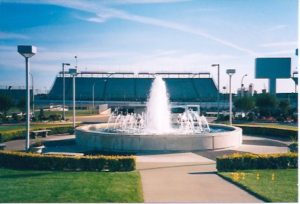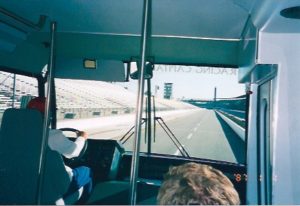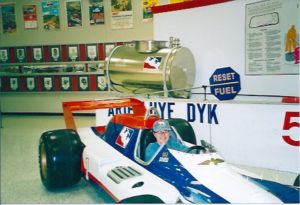‘Indy’ Inspiration: Growing Up Near The Racetrack

(or, How I got from there to here, part two)
By Dorothy Rice Bennett
The 101st Indianapolis Motor Speedway 500-Mile Race was run today. No matter where I am, I cannot let the “Indy 500” pass without watching. I grew up two blocks from the racetrack in Speedway, Indiana, and I was influenced by the roar of the engines, the excitement of so many visitors during race month, and my numerous visits to the track and the race itself.
Childhood dreams
When I began in the fifth grade at Speedway Elementary filling notebooks with stories about imaginary women of action—including race drivers—I was inevitably inspired by my close connection to Indy. In the alley half a block from my house, there was a garage where mechanics worked on racecars. Most  were “midgets,” smaller racing machines that performed on a regular basis at a half-mile oval across the street from the monster Indy track. But Kepler’s Garage also drew a few Indy cars. Kids from my neighborhood—several boys and me—would pass by that open-door garage and we would wander in to look closely at the race cars. The mechanics were patient with our youthful enthusiasm and would explain a thing or two before shooing us out the door in order to get their work done. We all imagined being race drivers one day (even me, a girl). Who wouldn’t? These were the celebrities of our world.
were “midgets,” smaller racing machines that performed on a regular basis at a half-mile oval across the street from the monster Indy track. But Kepler’s Garage also drew a few Indy cars. Kids from my neighborhood—several boys and me—would pass by that open-door garage and we would wander in to look closely at the race cars. The mechanics were patient with our youthful enthusiasm and would explain a thing or two before shooing us out the door in order to get their work done. We all imagined being race drivers one day (even me, a girl). Who wouldn’t? These were the celebrities of our world.
Speedway, Indiana, was a small town of 2,000 when I was
growing up. We were separate from Indianapolis, with a railroad track and a few feet dividing the city limits. I lived just off Main Street, which ended in one direction at 16th Street by the racetrack and the other end at 10th street by Allison Division of General Motors, which manufac tured jet aircraft engines. On one side of Main Street were small commercial businesses—the A&P, a movie house, a corner grill, drugstores, beauty shops, etc. On the opposite side were industrial firms, Esterline-Angus, Union Carbide, and so on. These businesses were officially inside Speedway, which received tax proceeds from them, benefiting our community and school district.
tured jet aircraft engines. On one side of Main Street were small commercial businesses—the A&P, a movie house, a corner grill, drugstores, beauty shops, etc. On the opposite side were industrial firms, Esterline-Angus, Union Carbide, and so on. These businesses were officially inside Speedway, which received tax proceeds from them, benefiting our community and school district.
Eleven months out of the year, Speedway was a quiet little town. We were suburban for sure (five miles from the central Indianapolis) and not much removed from rural Indiana farmlands. There wasn’t a lot to do except go out to eat, the movies, and church. Then May rolled around, the racetrack opened, and race drivers, many with their families, pulled in to town. The roar of the engines of cars practicing on the track could be heard at our house almost daily. Drivers’ sons and daughters entered our school system for the final month of the school year.
Young entrepreneur
By the time I was ten or eleven and entering my movie star craze stage of life, the Indy track became important to me in a new way. I had hobbies and I needed to make money to support my activities. The budding entrepreneur in me began to see the race as a way to make money.
Those 200,000 people who came on race day arrived in buses, cabs, and automobiles—mostly cars. The buses parked on Main Street in those days. Cabs dropped people off at the track. Cars had to park somewhere on their own. We had a big back yard, and I decided that with my parents’ permission, I wanted to fill  our yard with cars on race day. Going price was 50 cents (now it’s probably $20). I made signs and stood at the end of our alley and directed cars to the gates of our back yard. A friend shoed the cars into the yard, and my father watched that they parked without blocking one another. That first year, I filled the back yard, the front yard, and the driveway with vehicles and made several bucks for myself.
our yard with cars on race day. Going price was 50 cents (now it’s probably $20). I made signs and stood at the end of our alley and directed cars to the gates of our back yard. A friend shoed the cars into the yard, and my father watched that they parked without blocking one another. That first year, I filled the back yard, the front yard, and the driveway with vehicles and made several bucks for myself.
Race visitors appreciated our friendliness and returned the following year. Some brought bedrolls and slept under a tree in our back yard. Two older men asked if they could rent a room because the ground was hard on their backs. Others asked, when it rained, if they could sleep in our basement. We agreed, and I slept on the living room couch for the next few years. My mother made hot breakfasts for our regular visitors from Baltimore, Maryland, and Atlanta, Illinois. I set the table and served the food as my mother took it from the stove. Everyone was happy with home-cooked food, instead of risking the “greasy spoon” down the street or the high-priced vendors at the racetrack. I netted about $50 that May, a lot of money for a child at that time.
The farmers from Illinois, about a dozen of them, came annually. By the third year, they had a spare ticket for me, and I was privileged to attend the actual race, sitting across from the finish line in Grandstand A, a giant wooden structure that has since been replaced with concrete and steel. My excitement as a child cannot be described, watching those race cars roar by in front of me, talking about all the drivers, and rooting for my favorites. One experience like that makes a lifelong fan of a young kid. I was from Speedway, and this was OUR race!
Influences of Indy
Exposure to the Indy made me different than I would have been without that month of excitement every May. I rubbed shoulders with celebrities and their families, rode around in a convertible with a race driver and his children, and once as a teenager was privileged to actually drive around the racetrack—courtesy of the local Optimist Club, of which my father was a member. I was seventeen and had just earned my driver’s license. I barely speeded up to 40 mph on the track and was terrified of the banked curves, but I made it around, and my father generously
let me have the opportunity to experience it.
I left Speedway at seventeen to go to college; however, I learned that you can take the girl out of Indy  but not Indy out of the girl. I’ve always been a fan of beautiful and fast cars. My greatest thrill was having two Toyota Supras in the 1980s, definitely sporty, definitely fun to drive, and definitely satisfying to the Indy fan in me.
but not Indy out of the girl. I’ve always been a fan of beautiful and fast cars. My greatest thrill was having two Toyota Supras in the 1980s, definitely sporty, definitely fun to drive, and definitely satisfying to the Indy fan in me.
The Indy 500 was my big hometown adventure as a kid. It played into my desire to become a storyteller and write about the wondrous things I had experienced. Then, however, I was too close to that racing world, and my childhood novellas lacked perspective. Today, as I write novels, I can see Indy more clearly and my mind is working on it as part of a book. I now know what I want to say. So, lookout, Indy, I’m soon going to spin a tale about you!
[Top photo from my childhood, Main Street in Speedway with buses parked for the race. Remaining photos taken during a 1997 visit to Indianapolis, the track, and museum.]
For more information about the Indy 500 and Speedway, check out the following:
http://www.indianapolismotorspeedway.com
https://twitter.com/IMS?ref_src=twsrc%5Egoogle%7Ctwcamp%5Eserp%7Ctwgr%5Eauthor

Comments
‘Indy’ Inspiration: Growing Up Near The Racetrack — No Comments
HTML tags allowed in your comment: <a href="" title=""> <abbr title=""> <acronym title=""> <b> <blockquote cite=""> <cite> <code> <del datetime=""> <em> <i> <q cite=""> <s> <strike> <strong>